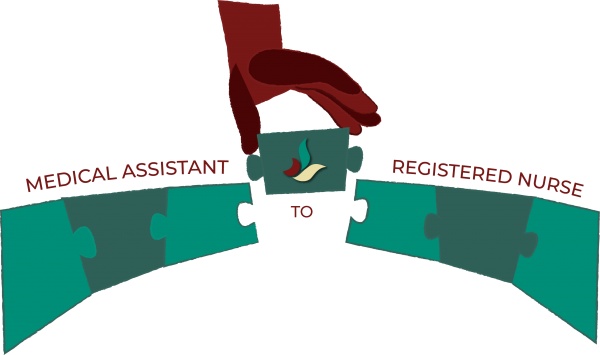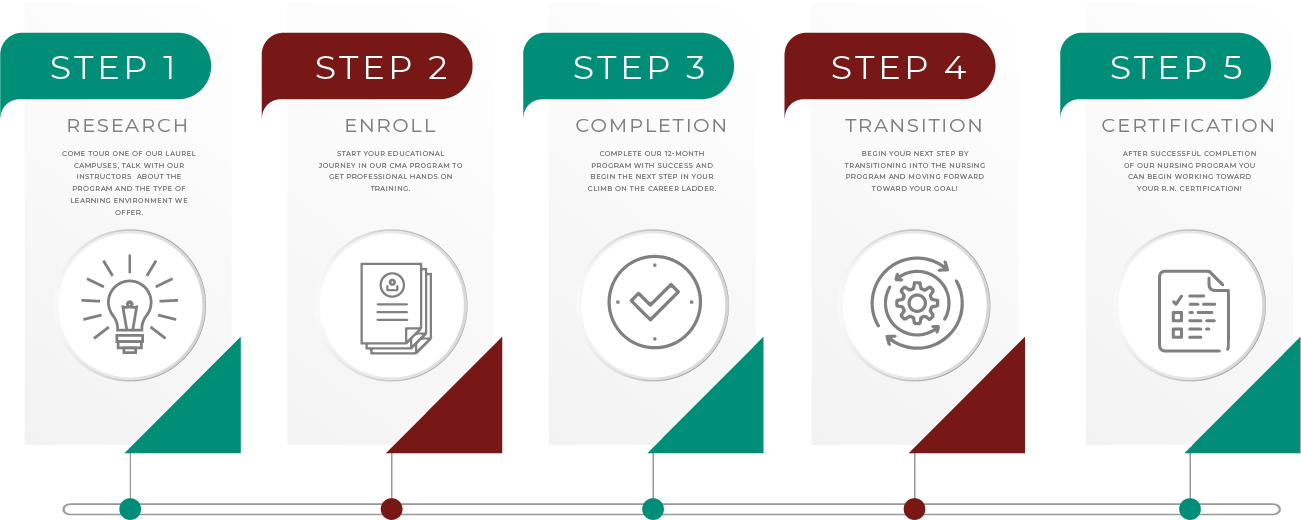How to go from CMA to RN at Laurel
Being a Clinical Medical Assistant (CMA) is a great first step to helping you climb the career ladder in the healthcare field. Laurel’s CMA graduates have a pathway to apply for direct admission into Laurel College of Technology’s Associate Degree of Nursing program. Although working as a CMA can be a prosperous and fulfilling career, you may want to take the next step! There are many opportunities to advance your career from Clinical Medical Assistant- if you are interested in a slightly more fast-paced hands-on role, then a career in Nursing might be your next step!
Here are some important things you need to know to help you prepare for this next step:
Start Fast with a 12-month Medical Assistant Diploma
While medical assistants and registered nurses both strive to provide quality patient care, their responsibilities and scope of practice differ. Medical assistants can have administrative and/or clinical responsibilities to help facilitate patient care. They can schedule appointments, greet patients as they enter the office, and help prepare the patient by taking vitals. While they can potentially earn a level of autonomy, MAs usually work under the care of a licensed physician or a registered nurse. Nurses play a greater role in providing patient care. While some of the tasks that MAs perform resemble the work of Licensed Practical/Vocational Nurses (LPN/LVN), nursing carries additional patient responsibilities, especially at the level of RN. RNs typically work one-on-one with patients. They create patient care plans, collaborate with other medical staff.
Both medical assistants and registered nurses work in healthcare environments, but have different roles! As a nurse, you can pursue your career in a variety of healthcare settings. RNs often work in hospitals. MAs most often work in physician’s offices or hospitals. If you’re interested in working in a more autonomous role in providing patient care in a hospital environment, going from MA to RN may be right for you. Many healthcare providers offer tuition reimbursement for employees wishing to further their education in the nursing profession.
Many other nurses will choose to work in the offices of physicians, outpatient care centers, home health care, nursing homes, and telemedicine. Although these are only some of the places that nurses can work, it depends on availability, location, and specialization.
Just like there are different types of medical assistants, there is no such thing as only bedside nursing. Nurses provide specific care for patients in a variety of different settings. However, as you choose to pursue a nursing career, you may decide that you want to specialize in an area that interests you. Some possible nursing specialties include, but are not limited to:
- Travel Nurse
- Pediatric Nurse
- Oncology Nurse
- Flight Nurse
- Intensive Care Unit (ICU) Nurse
- Emergency Room Nurse
- Cardiac Specialist
- Health Coach
- Intermediate Specialist
- Case Management
- Education Specialist
There are unconventional nursing careers that you may also choose to pursue once you have earned your ADN. Nursing represents both a great next career step for MAs and an excellent undergraduate foundation building a bridge to many future potential career paths.
Our CMA program teaches you important and necessary skills in just 12 months. During that time your course work will include anatomy and physiology, medical terminology, billing and coding, office management, and mathematics. Most importantly, you will learn technical skills such as procedures, injections, and medical office operations.
Transition to Registered Nursing
Our Nursing program takes 20 months to complete, which is 5 semesters. Laurel will work with you to transfer some credit earned in our CMA program to make your transition into our Nursing program seamless and comfortable! You will see a greater variety and focus on the specific courses in our Nursing program, examples include:
- Pharmacology
- Nursing care of the medical/surgical patient
- Nursing care of pediatric patients
- OBGYN nursing care
- Psychiatric nursing care
- Leadership and management
- Community/ Public health
With each of the above courses, nursing students learn bedside tasks that are needed for the care of various types of patients. For example, they learn to administer different medications (by different routes), start IVs, place and remove catheters, and other skills.








